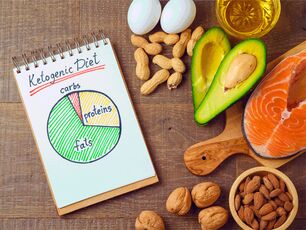
Fashion bloggers and sophisticated magazines are everywhere screaming about different weight loss methods: gluten-free diet, Kremlin, natural juices, according to blood type, and hundreds of others. You can discuss as much as you like about the effectiveness of each method, but what's the point if the main question for women still remains "how to lose weight? " Diets tend to have negative associations, as they imply restrictions and discomfort, but nutritionketogenic is difficult to attribute to them. The keto diet is rich in fats and proteins and minimal in carbohydrates.
How does it work?
Our body is designed to receive energy for its work from carbohydrates (glucose). An alternative source of energy is the breakdown of fats, or rather, the so-called ketone bodies. When blood glucose is low (without carbohydrates, this is inevitable), fat stores are used. By absorbing them as fuel for the body and brain, extra inches start to come out.
Consequently, the goal of a diet is to induce a metabolic state in which the amount of carbohydrates in the diet is reduced to a minimum and the amount of fat consumed is maximized.
Remember that any diet is stressful for the body and for the body. When choosing a way to lose weight, try to properly assess your health and fitness.
In 2016, the results of a study were published in which scientists and medical professionals studied the effects of a low carbohydrate diet on the body and the risk factors for cardiovascular disease. It was concluded that individuals with a low carbohydrate diet lost significantly more weight than those who continued to consume carbohydrates. The second side of the coin was that weight loss was associated with increased cholesterol, which is not good for health.
Today there are a large number of techniques that aim to reduce one of the BJU's indicators. The leader of recent years can be called the Ducan diet - a protein nutritional system consisting of four stages. Which way you prefer depends on you.
What is ketosis?
This is a state of the body in which ketone bodies or ketones become the main source of energy. In order for the body to start working in this mode, it is necessary to observe the starvation of carbohydrates for 3-4 days and then proceed with one of the appropriate types of ketone diet.
Types of keto diets
Classic.This is a low carbohydrate and fat diet. In fact, the entire article is dedicated to its classic version, in which the ideal proportion of BJU is: 75% fat, 20% protein and 5% carbohydrates.
Cyclic keto diet. In this case, it means alternating 5 days with strict adherence to the diet and 2 days of the so-called “cheat meal”, when the consumption of 400-500 g of carbohydrates per day is allowed, which allows the replacement of glycogen stores.
This option is used most often before or during increased and intense sport loads. This form of nutrition helps to speed up metabolism, burn fat and gain lean muscle mass. Many nutritionists insist that the correct diet must be balanced, therefore, among the dietary options listed, they prefer this.
Diet directed to the keto.Suitable for professional athletes, most often used by bodybuilders. In this case, it is allowed to consume carbohydrates an hour and a half before the start of training. This type of ketogenic diet allows you to replenish your glycogen stores so that you do not exhaust yourself and, at the same time, do not get out of ketosis.
Positive and negative aspects of the ketone diet
Pros:
- With a ketogenic diet, there is no dramatic change in nutrition and artificial calorie reduction, which usually leads to the fact that after weight loss, the weight returns and sometimes increases.
- As a rule, the feeling of hunger goes away and resistance increases.
- The ketone diet can help you lose weight quickly. That is why it is often used by public people to prepare for urgent filming or significant events.
- Low-carbohydrate diets are often preferred by people with insulin resistance and metabolic syndrome, because they see excellent results and resolution of chronic diseases. Reducing carbohydrates to ketogenic levels of 25-50 grams a day helps to keep insulin levels low and normal.
- The ketone diet was also recommended as a drug-free treatment for difficult-to-control childhood epilepsy. This is evidenced by research in 2016.
- It can be beneficial to lose excess fat and improve the general condition of people with type 2 diabetes. This was reflected in a foreign study in 2018, in which 2, 500 people participated. Some of the participants had a low-carb diet, while others ate more evenly. The main focus of the study was glycemic control. Through systematic observations, analyzes and comparisons, scientists have come to the conclusion that the ketone diet has a beneficial effect on the body and can be used as part of an individual treatment plan, under the supervision of a doctor.
Cons:
- The most common side effects are constipation, slightly low blood sugar or stomach pain.
- Less commonly, low carbohydrate diets can cause kidney stones or high levels of acid in the body (acidosis).
- Other side effects may include "keto flu", which includes headaches, chills, occasional fever, weakness, irritability and bad breath.
- When your body burns fat deposits, it overloads the kidneys and also increases ammonia levels in the blood.
- Poor diet and lack of balance. As carbohydrate intake is minimized, significant restrictions on food intake arise.
- Many people notice that in the beginning there is a general weakness of the body, lethargy and drowsiness.
- Ketone bodies are quite toxic to the body, so it is important not to defy fate on your own and seek professional advice from a nutritionist or doctor who will watch you during weight loss.
Contraindications
Who should avoid the keto diet?
- People with liver and kidney disease, high cholesterol and metabolic disorders.
- Diabetics are advised to try nutrition only under the supervision of a doctor.
- Pregnant and breastfeeding women.
What to eat and drink on a ketone diet? What foods can you eat?
Meatunprocessed, that is, without the processes of salting, preservation, smoking, etc. Pork, lamb, beef, duck, fatty portions of chicken and turkey, bacon and lard are suitable. Refrain from sausages and sausages.
Fish and seafood. Salmon, salmon, saury, sardines, mackerel, herring and any seafood are great. Avoid breadcrumbs in the kitchen as it contains carbohydrates.
Eggs. Eat in any form: boiled, stuffed, fried in butter, scrambled eggs, etc.

Vegetables growing above the ground. Favorites include cauliflower, cucumber, asparagus, avocado, broccoli, spinach, green beans and zucchini. Say goodbye to root vegetables: potatoes, beets, onions, carrots, celery root, etc. Use olive oil or butter to cook.
Dairy products: cottage cheese, butter, cheese, sour cream, sour cream. The main condition is that they are bold.
Nuts. Good for a different cashew nut snack. It is better to exclude this type due to its high carbohydrate content.
Oils and fats.If we talk about vegetable oils, give preference to olives. Coconut is also very popular, which can significantly diversify the palette of food flavors.
What to drink?
During the ketone diet, it is important to drink plenty of water, as water helps to eliminate toxins from the body.
A 2015 study found that replacing diet drinks with water after a main meal can lead to greater weight loss and also improve insulin resistance.
Eliminate all soft drinks and juices, energy drinks and smoothies and beer.
What to drink besides water? Coffee and tea without sweeteners, and wine is the least harmful in terms of carbohydrate content.
What foods to avoid?
First of all, you will have to gather all your will in one fist and give up what you usually pull: sweets, candies, cakes, cookies, chocolate bars, donuts and breakfast cereals. Sugar-free diets are very popular with women around the world and eliminate simple carbohydrates and refined sweeteners, which helps to reduce the risk of heart disease.

Starchy foods: bread, pasta, rice, corn, potatoes, peas, chips, cereals, muesli and so on. If you see the word "whole grain", put the product back on the shelf.
Vegetables, avoid beans and lentils first.
Try not to drink milk and say goodbye to coffee with milk (contains 18 grams of carbohydrates), avoid low-fat yogurt.
For fruits and berries, the best options are raspberries, strawberries, blueberries, watermelons and melons. Bananas, grapes, mangoes, pears, apples and kiwis can spoil carbohydrate statistics.
A smart person said that "losing weight without limiting food is the same as overcoming laziness without getting off the couch. " Get ready to work hard and change your eating habits.
An example of a week-long ketone menu
To diversify your diet and achieve your goals, you must love cooking. What can be the food during the week?
Monday
- Breakfast: scrambled eggs with ham, cheese and spinach.
- Lunch: chicken broth and vegetable salad seasoned with natural mayonnaise.
- Dinner: Fish baked with vegetables (green beans and vegetables) and brown rice.
Tuesday
- Breakfast: grated cheese omelette and steamed fish cakes.
- Lunch: tuna salad with avocado and lettuce mixture, seasoned with olive oil or natural mayonnaise.
- Dinner: vegetable stew with meat.
Wednesday
- Breakfast: boiled eggs and toast with cream cheese and avocado.
- Lunch: meat borscht.
- Dinner: seafood salad and cauliflower pancakes.
Thursday:
- Breakfast: 2 eggs and asparagus fried in butter.
- Lunch: puree soup and vegetable salad.
- Dinner: Mushroom Casserole.
Friday:
- Breakfast: smoked salmon and avocado sandwich.
- Lunch: fish soup.
- Dinner: fried with fresh spinach.

Saturday
- Breakfast: omelet with mushrooms and cheese.
- Lunch: chicken cooked with hummus and lettuce.
- Dinner: coleslaw and roasted turkey with a creamy cheese dressing.
Sunday
- Breakfast: mushroom casserole.
- Lunch: chicken soup.
- Dinner: chop with avocado and green beans fried in butter.
Conclusion: how many people, so many methods of losing weight. A ketogenic diet is a short-term diet that focuses on weight loss rather than health benefits. The results of clinical studies examining the effect of ketogenic diets are conflicting, so it should be practiced for no more than a few months and under the supervision of a doctor.






























